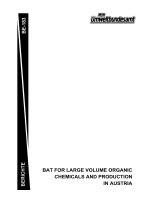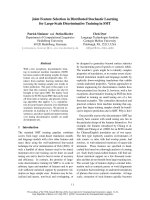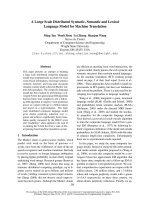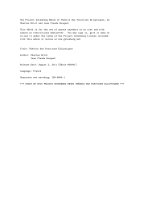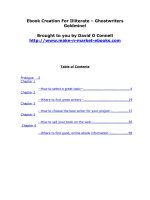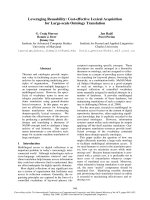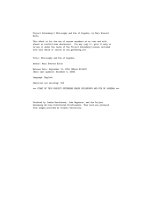Ebook Arranging for Large Jazz Ensemble Dick Lowell and Ken Pullig
Bạn đang xem bản rút gọn của tài liệu. Xem và tải ngay bản đầy đủ của tài liệu tại đây (14.47 MB, 202 trang )
___________
BERKLEE PRESS
Berklee Media
Berklee Press
Associate Vice President: Dave Kusek
Director of Content: Debbie Cavalier
Marketing Manager: Jennifer Rassler
Senior Graphic Designer: David Ehlers
Senior Writer/Editor: Jonathan Feist
Writer/Editor: Susan Gedutis
Production Manager: Shawn Girsberger
Product Marketing Manager: David Goldberg
ISBN
□-ЬЗЧ-ОЗЬБЬ-Ч
DISTRIBUTED By
lerkee
iress
1140 Boylston Street
Boston, MA 02215-3693 USA
(617) 747-2146
H a l *L e o n a r d ®
C
O
R
P
O
R
A
T
I
O
N
7777 W. BLUEMOUND RD. P.O. BOX 13819
Milwaukee, Wisconsin 53213
Visit Berklee Press Online at
Visit Hal Leonard Online at
w w w .b e rk le e p re s s .c o m
w w w .h a lle o n a rd .c o m
Copyright © 2003 Berklee Press
All Rights Reserved
No part of this publication may be reproduced in any form or by any means without the prior written permission of the Publisher.
Printed in the United States of America by Vicks Lithographic and Printing Corporation
10 09 08 07 06 05
5 4 3 2
Introduction
What this Book Covers
How to Use this Book and CD
A Note on Range Recommendations
Acknowledgments
About the Authors
1 Basic Information
1-1
1-2
1-3
1-4
1-5
1-6
1-7
Transposition of Instruments
Instrument Ranges and Sound Characteristics
Comparison of Instruments’ Ranges
Low-Interval Limits
Special Effects for Wind Instruments (CD Track 1)
Reharmonizing Approach Notes
Chord Scales
Tonal Context
In Tonic Major
In Tonic Minor
Modal Interchange Used in Major
Chord Scales for the V7 Chord (Primary Dominant Seventh)
Secondary Dominant Seventh Chord Scales
Substitute Dominant Seventh Chord Scales
Special Function Dominant Seventh Chord Scales
Diminished Seventh Chord Scales
Modal Chord Scales
1-8
Preparing a Score
1-9
Overview of an Arrangement
Elements of Form: Intros, Interludes, and Endings
Modulation and Reharmonization
Graphing an Arrangement
1-10 Exercise
2
Unison and Octave Writing
2-1
2-2
2-3
2-4
2-5
2-6
2-7
ii
Procedure
Orchestration and Timbral Effects
High-Timbre Unison (CD Tracks 2-5)
Medium-Timbre Unison (CD Tracks 6-7)
Low-Timbre Unison (CD Tracks 8-10)
Octave Doubling (CD Tracks 11-15)
Melodic Subdivision (CD Tracks 16-18)
Abrupt Fragments
Smooth Flow
vi
vi
vii
vii
viii
viii
1
1
3
7
8
9
11
15
16
17
18
19
20
20
21
23
24
25
28
29
30
30
31
33
33
34
35
36
36
37
38
38
39
2-8
2-9
3
Concerted Writing with Mechanical Voicings
3-1
3-2
3-3
3-4
3-5
3-6
3-7
4
Procedure
Coupling the Saxes to the Brass
Recommended Ranges for Lead Instruments
4&4 Concerted Writing
With Constant Coupling (CD Tracks 20-21)
With Variable Coupling (CD Track 22-23)
With Full Doubling (CD Track 24)
Concerted Writing for 5&5, 7&5, and 8&5
5&5 with Constant Coupling (CD Track 25)
7&5 with Variable Coupling (CD Track 26)
8&5 with Constant and Variable Coupling (CD Track 27)
Avoiding Repeated Notes
Editing to Eliminate Repeated Notes
Crossing of Voices
Reharmonizing Approach Notes
Exercises
Spread Voicings
4-1
4-2
4-3
4-4
5
Short Subdivisions, Two Groups
Longer Subdivisions, Three Groups
Longest Subdivisions, Two Groups
Contrapuntal Application (CD Track 19)
Exercises
Procedure
Spreads for 4&4 and 5&5
Five-Part Spread for 4&4 Under Unison Melody (CD Track 28)
Concerted Melody for 5&5 with Five-Part Spread (CD Track 29)
Tutti Writing Using Spreads
Five-Part Spread for 5&5 (CD Track 30)
Eight-Part Spread for 7&5 Coupling Baritone with Brass
Mixed-Timbre Spread for 8&5 (CD Track 32)
Beyond Standard Orchestration
Exercises
Voicings in Fourths
5-1
5-2
5-3
Procedure for Voicings in Fourths
For 4&4
For 5&5
For 7&5
For 8&5
Sample Passages Voiced in Fourths
4&4 Conceited Writing Using Fourths (CD Track 33)
5&5 Tutti Using Fourths (CD Track 34)
7&5 Concerted Melody Using Fourths (CD Track 35)
8&5 Subdivided and Concerted Melody Using Fourths (CD Track 36)
Exercises
40
41
42
43
45
49
49
50
50
51
51
53
55
55
55
56
56
57
57
59
60
61
63
63
67
67
67
68
68
69
70
70
71
73
73
74
75
75
76
77
77
78
79
80
81
iii
6
Upper Structure Triad Voicings
6-1
6-2
6-3
6-4
6-5
6-6
7
Voicings in Clusters (Seconds)
7-1
7-2
7-3
7-4
7-5
7-6
8
8-5
8-6
Procedure
Five-Part Saxophone Soli (CD Track 45)
Line Writing in a 5&5 Concerted Passage (CD Track 46)
Building from the Bottom for Contrary Motion (CD Track 47)
Five-Part Line Writing, Bottom First
Five-Part Line Writing in 7&5 Ensemble
Cascade Effect (CD Track 48)
Exercise
Woodwind Doubling and Muted Brass
9-1
9-2
9-3
9-4
iv
Procedure
For 4&4
For 5&5
For 7&5
For 8&5
4&4 Using Clusters in Brass Counterpoint (CD Track 41)
5&5 Saxophone and Brass Counterpoint (CD Track 42)
7&5 Concerted Melody in Clusters (CD Track 43)
8&5 Sustained Texture and Counterpoint (CD Track 44)
Exercise
Line Writing
8-1
8-2
8-3
8-4
9
Procedure
For 4&4
For 5&5
For 7&5
For 8&5
4&4 Upper Structure Triad Voicings (CD Track 37)
5&5 Concerted with Supporting Spreads (CD Track 38)
7&5 Reharmonized Melody (CD Track 39)
8&5 Dominant Seventh Reharmonization (CD Track 40)
Exercise
Woodwind Doubling
Muted Brass
Characteristics and Ranges for Five Mutes
Practical Considerations for All Mutes
Applications of Woodwinds and Muted Brass
Unison and Octave Combinations (CD Tracks 49-52)
Voiced Woodwinds (CD Tracks 53-54)
Large Ensemble, Various Woodwinds and Muted Brass Effects
(CD Track 55)
Exercise
83
83
83
85
86
87
88
89
90
91
93
95
95
96
96
97
97
98
99
100
101
103
105
105
107
109
111
111
111
114
115
117
117
119
119
122
123
123
124
126
129
10 Soli Writing
10-1
Procedure
Suggested Lead Ranges for Soli Writing
Creating the Lead Line
10-2 Saxophone Solis
Four-Way Close, Double Lead (CD Track 56)
Line Writing (CD Track 57)
10-3 Brass Solis
For Four Trumpets, Three Trombones (CD Track 58)
For Four Trumpets (CD Track 59)
For Three Trombones (CD Track 60)
10-4 Exercise
11 Background Writing
11-1
11-2
11-3
11-4
12
Riff Background (CD Track 61)
Backgrounds Based on Guide Tone Lines
Compositional Approach
Exercises
Shout Choruses
12-1 Characteristics
12-2 Recommended Listening
12-3 Analysis of Shout Chorus (CD Track 62)
Inventing the Shout Melody
The Big Picture
12-4 Exercises
13
Style (Five Versions of The Birthday Song)
13-1
13-2
13-3
13-4
13-5
Early Jazz Style (CD Track 63)
Arrangement by Bill Seism
Count Basie’s Style (CD Track 64)
Arrangement by Scott Free
Duke Ellington’s Style (CD Track 65)
Arrangement by Jeff Friedman
Bill Holman’s Style (CD Track 66)
Arrangement by Ted Pease
Gil Evans’ Style (CD Track 67)
Arrangement by Greg Hopkins
14 Analysis of a Complete Arrangement
14-1 Schematic of the Arrangement
14-2 Lead Sheet
14-3 The Score and Commentary (CD Track 68)
131
131
131
132
133
133
133
135
135
136
136
137
139
139
143
144
147
149
149
150
151
151
154
155
157
157
161
167
171
177
184
184
185
186
v
Introduction
What this Book Covers
The large jazz ensemble, or big band, has a prominent place in the history of jazz. Some
of the most dynamic personalities of jazz—Duke Ellington, Count Basie, Woody
Herman, Buddy Rich, Stan Kenton, Maynard Ferguson, Gil Evans, and Thad Jones—
were leaders of large jazz ensembles. Their bands were instantly recognizable by the
unique musical personalities of the arrangers and composers who wrote for them. Today,
Bob Brookmeyer, Bill Holman, Maria Schneider, Jim McNeely, Rob McConnell, and
many other great writers and band leaders keep that tradition alive, continuing the big
band as an important outlet and creative challenge.
This book is your guide to creating jazz arrangements for such large ensembles. It covers
the following subjects.
Basics: We quickly review fundamental concepts that all arrangers need to have under
their belts.
Voicing Techniques: Starting with simple unison- and octave-writing strategies, we then
spend many chapters exploring the use of mechanical voicings, spreads, voicings in
fourths, upper structure triad voicings, and clusters. We also examine such specialized
techniques as line writing and the use of woodwind doubling in combination with muted
brass.
Soli, Background, and Shout Choruses: Separate chapters analyze and present
procedures for creating each of these trademark elements of big band arrangements.
Style: This discussion examines the question of what defines an arranger’s style by
comparing different versions of “Happy Birthday,” done in the parodied styles of Duke
Ellington, Count Basie, Gil Evans, and others.
Analysis of a Complete Arrangement: The final chapter presents an annotated score
of a full-length arrangement that demonstrates many of the principles presented in
preceding chapters. As with most of the musical examples, the reader has at his or her
disposal not only written music but also a recorded performance of this complete
arrangement on the CD.
The large jazz ensembles discussed in this book are described variously as 4&4s, 5&5s,
7&5s, and 8&5s. A 4&4 has four brass (usually three trumpets and one trombone) and
four saxophones (usually one alto, two tenors, and one baritone). A 5&5 has five brass
(usually three trumpets and two trombones) and five saxes (usually two altos, two
tenors, and one baritone). A 7&5 has seven brass (usually four trumpets and three
trombones) and five saxes (usually two altos, two tenors, and one baritone). An 8&5 has
eight brass (usually four trumpets and four trombones, including a bass trombone) and
five saxophones (usually two altos, two tenors, and one baritone). The rhythm section
for such large ensembles consists of piano, bass, drums, and, very often, guitar.
Throughout this book, we primarily focus on what to write for the horns, since they
traditionally dominate most big bands. It is important to remember, however, that a
successful arrangement also needs detailed and clear parts for the rhythm section
players. A good arranger will facilitate their supportive “comping” role and occasionally
make use of their orchestral potential, both in the doubling of horn lines and as
a separate unit to contrast the horn section.
INTRODUCTION
How to Use this Book and CD
If you are new to arranging, we suggest you start with the review of basic nuts-and-bolts
information provided in Chapter 1. Even seasoned arrangers may want to refresh their
knowledge of these key concepts. And as they progress through the rest of the book,
most readers will probably find it useful to dip back into Chapter 1 for reminders about
such things as the ranges of specific instruments, appropriate choices for chord scales,
or the positioning of rehearsal letters on a score.
For a more thorough discussion of the basics, we recommend Modern Jazz Voicings by
Ted Pease and Ken Pullig (Berklee Press, 2001). Beginner and intermediate arrangers
will want to study its explanations of mechanical and nonmechanical voicing techniques
for small ensembles. A working knowledge of these techniques is a prerequisite for
grasping the arranging methods for large ensembles that are covered in this book.
As you move into the meat of the book in Chapter 2 and beyond, we suggest that you
learn the material in the following way:
1. Read through the procedure or description for each arranging strategy, making sure
you grasp the theoretical basis as well as the step-by-step “recipe.”
2. Study the written examples to see how the strategy should be applied in a specific
musical situation. Examples range in length from a few measures to entire pieces.
3. Listen repeatedly to the corresponding recorded demonstration in order to actually
hear—and eventually internalize the sound of—the musical effect. The
1 CD symbol tells you which of the more than 60 tracks to listen to.
4. Practice the technique by completing the exercises that appear at the end of most
chapters.
A Note on Range Recommendations
The range guidelines we recommend throughout the book focus on the practical range
within which the average player will be comfortable. They are intended to encourage the
best ensemble balance and blend. Going beyond these boundaries will put players into
extreme high and low registers where it is more difficult to control intonation and tone.
When writing for professional-level players, these limitations can be extended. This is
why our range charts sometimes include notes beyond the practical range. For instance,
a professional lead trumpet player will be able to play a high concert / above high c,
well beyond our suggested practical limit of high a-flat, one ledger line above the staff.
But the lead player in the average high school, college, or amateur band will be unable
to play that high/consistently—or, perhaps, at all! When you do not know the abilities
of the musicians in a band, play it safe by remaining within the practical range.
A R R A N G I N G FDR LARGE ENS E MR LE
Acknowledgments
Many thanks to our colleagues in the jazz composition department at Berklee College of
Music for their ideas, suggestions, and musical contributions: Ted Pease, Greg Hopkins,
Scott Free, Jeff Friedman, Bill Seism, Bob Pilkington, and Jackson Schultz.
About the Authors
Dick Lowell, Associate Professor in the Jazz Composition Department, has taught at
Berklee College of Music for thirty years. An active composer and arranger, he has
written the majority of original compositions and arrangements for three CDs released
by the New York-based Dave Stahl Big Band. Trombonist Rick Stepton was featured on
his arrangement of “My Buddy,” written for the Buddy Rich Big Band. His
arrangements can be heard on CDs by the Ken Hadley Big Band backing vocal great
Rebecca Paris. He is also under contract with Heavy Hitters, a production company
specializing in prerecorded music for television. Segments of his music are being used
on daytime television. An active trumpeter, he has performed with a variety of
entertainers including Tony Bennett, Sammy Davis Jr., Jack Jones, Shirley Bassey, Carol
Channing, Ray Bolger, Jerry Lewis, and Mel Torme. He has also played in the Harry
James and Artie Shaw big bands.
Ken Pullig joined the faculty of Berklee College of Music in 1975 and was named Chair
of the jazz composition department in 1985. He was awarded a Massachusetts Council
of the Arts Fellowship in 1979 for his extended jazz composition, “Suite No. 2 for Small
Jazz Ensemble.” For many years he led his ten-piece jazz ensemble Decahedron in
performances throughout New England. A freelance trumpeter, he is regularly featured
with the Cambridge Symphonic Brass Ensemble. He has performed with Mel Torme,
Ray Charles, Johnny Mathis, Rita Moreno, Dionne Warwick, and many others. In recent
years, Pullig has presented clinics on jazz composition and arranging in France, Finland,
Germany, and Argentina. In 1997, he was guest conductor/composer with the Jazz
Company in Vigevano, Italy.
о
р
и
.
Basic
Information
IN THIS CHAPTER
1-1
1-2
1-3
1-4
1-5
1-6
1-7
1-8
1-9
1-10
Transposing from concert pitch to an instrument's written part.
Range limits and sound characteristics for big band instruments.
Comparison of instruments' ranges.
Limits on lower intervals to avoid muddy voicings.
Special effects for wind instruments.
Reharmonizing approach notes.
Chord scales: which scales work with which chords.
Preparing a score.
Overview of an arrangement.
Exercise
1-1 Transposition of Instrum ents
Use the table below to transpose parts for instruments commonly included in large jazz
ensembles. For example, in order to have an El? alto saxophone play a concert b-flat
pitch, you write the note g on the alto’s part a major sixth above what would be written
in the concert score.
Instrument
Concert Pitch
I"
Flute
Д
u
Bb Clarinet
^
11
Written Note
-
i
u
^
°
Transposition from Concert Pitch
-
—
Non-transposing
=
Up a m ajor 2nd
Up a m ajor 2nd
Bb Soprano Sax
Eb Alto Sax
Bb Tenor Sax
I"
fls
i
u
^
I
fls
u
~
~
-
=
Up a m ajor 6th
=
U P a m ajor 9th
1
A R R A N G I N G FOR LARGE J A Z Z E NS EM RL E
Instrument
Eb Baritone Sax
Concert Pitch
Written Note
$
/ '
Transposition from Concert Pitch
---------------------------------
Up a m ajor 13th
(octave + m ajor 6th)
°
Up a m ajor 9th
-eДц
Bb Bass Clarinet
Bb Trumpet
or Fliigelhom
Jf
/
French Hom in F
—
—
-
—
—
0-
о
Up a m ajor 2nd
~
~
3 Per*ect ^
-e-_______________
Non-transposing
Bb Trombone
Bb Bass Trombone
Tuba
m
-------------------------------
V -
-
—
Bass
2
9 '-
n ~
Non-transposing
^
-
Guitar
m
Ду
Non-transposing
u
—
Up an octave
4
У
Up an octave
CHAPTER I I RASIC I N F O R M A T I O N
1 -2 Instrum ent Ranges and Sound Characteristics
For each instrument commonly used in large jazz ensembles, the following charts
describe the available range as well as the timbral characteristics and the useable
dynamic levels within certain registers. The limits of the practical range, within which
the average player will be comfortable, are shown by vertical arrows pointing to
darkened note heads. The theoretical extremes are shown by open note heads; arrows
pointing upward to question marks are meant to suggest that for brass instruments, the
upper limit is set only by the technical skills of the individual.
Range and Sound Characteristics Chart
In all examples that follow, • = practical range.
Harsh sound, difficult to control,
“honk” register
Rich — ►thinner
W ff
p ff
/
P f
f
Bright to brighter
PP f f
PP f f
Becom ing thinner to shrill
rn p-f
P ff
Eb Baritone Sax
-G-
written
b
(5)
Ь-CT-
Som e baris have F# key
M any baritones have the
low A key
\>Л. (t|A)
sounding
Full, rich
mf - f f
Becom ing less full
and foundation-like
mP f f
Rich, blendable
p p -ff
Thin, but very
expressive
p p -ff
Difficult to
control intonation
p ff
з
A R R A N G I N G FOR LARGE J A Z Z E NS E M H LE
Bb Trumpet
o
written
sounding
Clear, rich, very
controllable
W ea k, non-projecting,
difficult to control
p p -ff
m p -m f
Piercing, penetrating
(lead trum pet range)
C lear, bright
f
f
-
f
m p -f
f
Bb Fliigelhom
written
sounding
m
FtP-
17
V ery rich, m ellow
(softer quality than trum pet)
Full, dark, sonorous
P mf
Becom ing thinner and constrained,
penetrating
ff-f
Horn in F (French horn)
written
sounding
I
*
\}ST“Pedal tones,”
difficult to control
•f-f
Dark
W arm , blendable
p-f
•f-f
Rich, more
expressive
p-f
-9V ---------------Bright
Penetrating,
projecting
ff
Bb Trombone
written &
sounding
T h e se notes unavailable
without F attachm ent
4
Low, dark
spread sound
p-f
C entered, Clear, melodically
low sound
expressive
pp-ff
pp-ff
Bright
Penetrating
n p-ff
ff
CHAPTER I I HA SIC I N F O R M A T I O N
Tuba
written &
sounding
Full, spread sound
P f
Focused, “Foundation”
sound
pp f f
C lear, sonorous,
very blendable
B ecom es thinner and penetrating,
difficult to blend
p - f
P~f
Flute
о
written &
sounding
V elvety, soft
PP P
G radually clearer
PP f
C lear
Bright
mp - m f
mf - f
Brilliant, shrill
f
ff
Bb Clarinet
written
sounding
rich, becom ing thinner
PP f
“Clarion” register
P mf
PP f f
mf f f
Bass Clarinet
written
sounding
PP f
P mf
mf
ff
5
A R R A N G I N G FDR LARGE J A Z Z E NS E M R LE
Bb Soprano Sax
#*)
written
S om e sopranos have
F# key
fe )
sounding
$
-W-
\>-9Harsh sound, difficult to control
/
C learer sound,
m ore blendable & expressive
PP f
Bright, projecting
mP ,ff
Thin
f
f
- f
f
Guitar
For a better understanding of the guitar’s capability to play and voice chords, consult The Jazz Style ofT al Farlow by Steve Rochinski,
The Advancing Guitarist by Mick Goodrick, or Everything About Guitar Chords by Wilbur Savidge.
Bass
written
sounding
Arco: heavy, coarse, dark
Pizz: dark, sonorous
8va - -i
Dark, percussive, heavy
6
CHAPTER I I HASIC I N F O R M A T I O N
1-3 Com parison off Instrum ents' Ranges
By comparing the ranges of big band instruments in concert pitch, this chart shows at a
glance where the instruments overlap. This is important to know as you plan your
orchestration of voicings (see Chapters 3 through 7) and lines that are to be scored in
unison and/or octaves (see Chapter 2).
(middle C)
I
Trumpet
m
Alto
7
A R R A N G I N G FOR LARGE J A Z Z E NS E MR LE
Lo w -lnterval Limits
To ensure that your voicings create a clear impression and that the intervals they contain
will be heard distinctly, do not include intervals below the limits shown in the chart
below. There are always exceptional cases in which these limits may be adjusted
downward. But if you follow them strictly, your voicings will never sound muddy.
unison (unlimited)
minor 2nd
major 2nd
4 V-------------------------------- ----rtB--------------------------/
perfect 4th
J
minor 3rd
Lido------------------------ — im-----------------------=
augmented 4th diminished 5th perfect 5th
t?o---------------:--------------:
major 3rd
, n------------------rW----------------bo
bo--------
minor 6th
*
§
=
=
:
major 6th
—
[m
-----1
Ш
---------------------------- -------e----------------------------------------e-----------------------------L о
i XL
bS
diminished 7th
minor 7 th
major 7 th
EE
XT
XT
СГ
major 9th
minor 10th
1л
minor 9th
octave (unlimited)
major 10th
4 ^ — e---------------------------------- ------0--------------------------------- -----kn-------------------------------------[ZA-1--------------------------------- -------e-------------------------------------J 1----------------------------------------k-e¥
\>TT
Whenever the bottom note of a voicing is not the root, “assume” there is a root and then
check that the voicing follows the low-interval guidelines. In the example shown below,
the C7 voicing conforms to the guidelines. But in the A-7 voicing, after we assume the
root, the resulting minor third interval falls below recommended low-interval limits (LIL)
C7
/
A-7
-------------------------
------ £ ------------------------------------
f
\
)
■o
(Problem)
minor 3rd is LIL violation
/
^ ----------------- ------ --------------------------------------n ------------------ —
------------------------------------(r25-)-----------------------------------U
(OK)
8
T
(assumed root)
CHAPTER I I RA SIC I N F O R M A T I O N
1 -5 Special Effects for W ind Instrum ents
Arrangers for large jazz ensemble often use special effects for the wind instruments. You
may use them in passages that involve the entire band, individual featured sections, or
smaller mixed groups within the ensemble. The lead player dictates exactly how these
effects will be performed and the rest of the band follows.
( l ) Shake. Brass players rapidly oscillate upward to the next highest note in the overtone
series, or sometimes to a wider interval for a more dramatic effect. Saxophone and
woodwind players trill to the next highest diatonic or chromatic note.
@
Fall (or Falloff or Spill). A fall is a downward drop from a specific note to an
indefinite ending pitch. Brass players glide down through the overtone series,
smoothing the shape using half valves on trumpet or the slide on trombone.
Saxophone and woodwind players lightly finger a descending chromatic scale.
Falls may be short or long as indicated by the length of the curved line off the note.
( ? ) Doit. Like a fall but moving in the opposite direction, this effect starts on a note and
slides upward to an indefinite ending pitch.
(7 ) Connecting Gliss. A connecting gliss is a rapid scalewise run or slide between two
definite pitches separated by a leap. It may go either up or down.
(? ) Flip (or Turn). Played when going from a higher pitch to a lower one, a flip
combines an upward gliss to a neighboring tone or indefinite pitch with a downward
gliss to the target note.
(6 ) Smear (or Bend). Players slide or bend into pitch, starting flat and moving upward
to the correct pitch. A short smear sounds like a quick “scoop” into pitch; a long
smear is а щоге extended approach.
( 7) Plop. This effect is used to approach a middle-register or low-register note preceded
by a rest. From a higher, indefinite starting pitch, a player moves rapidly down
through a scale or overtone series to end on the target note. To make the rapid
descent, trumpeters use half valves, trombonists use the slide, and saxophonists
and woodwind players finger a diatonic or chromatic scale.
( ? ) Rip. Like a plop but moving in the opposite direction, a rip approaches a middle- or
high-register note from an indefinite pitch below.
9
A R R A N G I N G FOR LARGE J A Z Z EN S E MR LE
A
This example shows all these effects, identified in the score by number. Listen to the CD
to hear how they sound.
Slow Swing J = 88
ID
CHAPTER I I BASIC I N F O R M A T I O N
1-6 Reharmonizing Approach Notes
When harmonizing a melody, an arranger needs to distinguish between target notes and
approach notes. Target notes are long or emphasized chord tones and tensions. They are
harmonized using chord sound. Approach notes, short notes that lead stepwise to targets,
are reharmonized to keep their “undervoices” lines compatible with the melody’s
movement. The chords arising from this reharmonization do not disturb the primary
harmony of the passage because they resolve back quickly to the harmony of the target
notes.
The standard reharmonization techniques reviewed below are chromatic, diatonic,
parallel, and dominant. Because the reharmonization of approach notes plays such a
critical role in arranging, we will regularly draw the reader’s attention to instances of it
as we look at examples of voicing and orchestration strategies throughout this book.
Reharmonizing Specific Approach Note Patterns
1. Chromatic Approach (ch): When an approach note moves by a half step to a chord
tone or tension target note, it is known as a chromatic approach: chromatic approach
notes are usually nondiatonic.
C6
„------ S----(ф 4 7-----• —
5
(ch)
Л
A
6
Chromatic Reharmonization: Each voice moves a half step into the corresponding note
of the target voicing, in the same direction as the melody, as shown below.
C6
5
(ch)
6
£
(B6)
Щ
P
7
Chrom atic
2. Scale Approach (S2, S4, S^6, etc.): When an approach note moves by a diatonic
whole or half step to a chord tone or tension target note, it is known as a scale approach.
(The “S” labeling relates to the chord of the target note.)
A7(b9)
(S2)
(S b6)
b7
D-7
(ch)
Tb9
5
G7
(S 4)
ЬЗ
T13
m
C6
и
A R R A N G I N G FDR LARGE J A Z Z E NS E MR LE
The voicings in the following example were created using all the standard techniques for
reharmonizing approach notes. In addition to chromatic reharmonization, these are:
• Dominant Reharmonization: The approach note is voiced with a dominant seventh
chord, either pure or altered, serving as the V7 of the target chord. The approach note
must be a chord tone of that V7 or one of its tensions.
• Parallel Reharmonization: This method matches the precise motion of the lead to that of
each voice below it. In other words, each undervoice moves the same number of semi
tones into its note in the target voicing. This technique may be used to voice any kind of
approach note—including chromatic approaches, as discussed above.
• Diatonic Reharmonization: Each voice moves one diatonic step into the corresponding
note in the target voicing. This works best when both melody and harmony are diatonic
to the key or to the current harmonic situation as outlined by the chord progression.
C6
A7(b9)
D om inant
12
Parallel
D-7
Chrom atic
G7
Diatonic
C6
CHAPTER I I RA SIC I N F O R M A T I O N
3. Double Chromatic Approach
When two notes of short and equal duration approach a chord tone or tension target
note by consecutive half steps in the same direction, they form a double chromatic
approach pattern.
G7
i i - в ----------
M— b*
(ch
к----- 7^
ch)
To voice double chromatic approach notes, use chromatic reharmonization with
voices following the same direction as the melody.
(ch
ch)
Double Chrom atic
4. Indirect Resolution (SS), (ch ch), (S ch), or (ch S)
When two notes of short and equal duration approach a chord tone or tension target
note by stepwise motion from opposite directions, they form an indirect resolution
pattern.
G7
—
S 4—
(ЪЖ ф-------- Ш= u
(S 2)
-----—
Ц---- 7®
(ch)
13
A R R A N G I N G FOR LARGE J A Z Z E NS E MR LE
When handling indirect approach notes, reharmonize each approach note independently.
The two notes may be reharmonized using different methods, as in this example.
(S 2)
$
(ch)
4 .
1
»— <
A -7
\
1*
.t
J»---------------------------------------------------
FJ
f
V—
T
t
Diatonic Chrom atic
(to G 7) (to G 7)
#
* (G 7 is the target note chord)
Independent Lead
The independent lead technique is an alternative to reharmonizing approach notes. In
this method, the voices below the approach note simply maintain the prevailing
harmony, or in some cases, the lower voices may rest. Independent lead works well
where a less driving feel is acceptable, and for pickups.
A-7
14
G-7
Fmaj7
CHAPTER I I BA SIC I N F O R M A T I O N
1-7 Chord Scales
A chord scale is a set of stepwise pitches related to a chord symbol that provides
a supply of notes compatible with that chord’s sound and its tonal or modal function.
Chord scales are an arranger’s raw material for writing voicings and lines that are
consistent with a given harmonic and melodic context.
In the chord scales shown on the following pages, chord symbols and Roman numeral
functions relate to middle с as the principal pitch axis unless otherwise indicated.
Chord tones and tensions are notated with open noteheads (o). Arabic numbers describe
their interval distances from the root of the chord. Tensions are numbered as upper
structure extensions (9, 11, 13) of the chord and preceded with “T.”
Avoid notes are notated with closed noteheads (#). Arabic numbers describe the interval
distances from the root, in the lower structure (1 through 7). Avoid notes are preceded
with an “S” to indicate the “scale approach” function.
For a thorough discussion of tensions, avoid notes, and chord scale theory, see Modem
Jazz Voicings by Ted Pease and Ken Pullig (Berklee Press, 2001).
15
